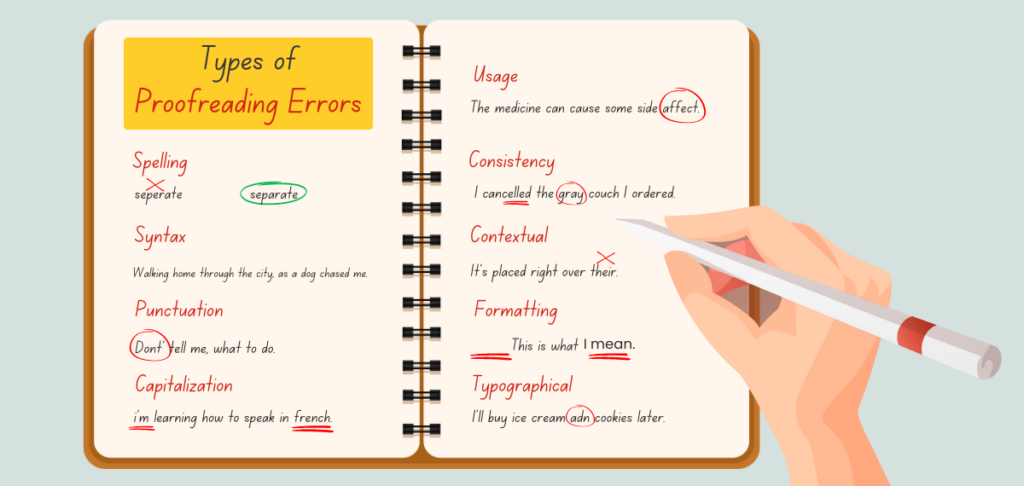Proofreading errors are those troublesome, uninvited guests in written work that can range from minor typos to major tangles in syntax, spelling, and grammar. They’re not just mistakes; they’re missed opportunities for the writing to shine in its clearest, most polished form.
As someone who comes from both worlds (editing and writing), I know just how crucial each step of the editing process is. Thorough proofreading and editing are so important in achieving professional and effective communication through all forms of writing, giving quality assurance to every single word on the page.
Ready to study up on some error-free writing? Let’s take a look at the common pitfalls and how to avoid them with these pro tips!
What Are the Types of Proofreading Errors?

You’d probably be surprised to discover just how many proofreading errors could arise in a piece of written work. Let’s break it down.
Spelling Errors
These are simply incorrectly written words that can change meanings or confuse readers altogether.
Examples:
- Definately instead of definitely
- Seperate instead of separate
- Form instead of from
The Fix: A combination of spellcheck tools and attentive reading should tackle most of these surface errors.
Grammar Errors
These common mistakes are found in the structure of sentences, which affect their readability and clarity. Examples include incorrect verb tenses and subject-verb disagreements.
Example: “She go to the store” should be “She goes to the store.”
The Fix: Familiarize yourself with grammar rules, tenses, and POVs (points of view). Also, software like Grammarly can be a big help in flagging most of these errors.
Syntax Errors
Syntax is the arrangement of words and phrases dictating how sentences are constructed. When this isn’t done correctly, it jars the readers because they have to stop and figure out why the sentence doesn’t flow.
Example: “Walking home through the city, as a dog chased me” reads much better when written as “A dog chased me as I walked home through the city.”
The Fix: Reading sentences aloud can definitely help identify and rectify awkward syntax. I always recommend a second go-over using Microsoft Word’s read-aloud feature too. Sometimes, the ear can pick up things the eye misses.
Punctuation Errors
These symbols are what structure and clarify the text. The misuse or absence of these critical marks just turns the writing into a total, unreadable mess.
Look for things like missing commas or overused semicolons. I know, I know, but writers love semicolons! Take it from me. They’re not as helpful as you think they are.
Examples:
- “Dont” instead of “Don’t”
- “My friend is coming over.” Said Mary.
The Fix: Always keep a punctuation guide handy. Also, proofread with a focus on each sentence’s rhythm. The above sentence example should look like:
- “My friend is coming over,” said Mary.
Capitalization Errors
The incorrect use of uppercase letters, or lack thereof, can completely muck up a sentence. As a proofreader or editor (heck, even writers should know this), it’s important to know when and where capitals need to be used.
Examples:
- english instead of English
- shi tzu instead of Shi Tzu
The Fix: Check for proper nouns and the beginning of sentences to apply capitalization correctly. Again, many of the proofreading software out there, like Grammarly Premium, will flag most of these mistakes, too.
Bonus: You can always use the Grammarist punctuation guide as a quick reference when editing or proofreading a document!
Usage Errors
Every writer, regardless of their skill level, messes this one up at least once in any given document. Usage errors boil down to incorrect use of a word or phrase.
Example: Using the word “effect” instead of “affect.” It might seem like such a minor mistake, but these two words, while similar sounding, have two completely different meanings.
The Fix: Enhance your vocabulary awareness and double-check word meanings. We actually have a guide that includes a list of the most commonly confused words that you can save or print to use as a reference when proofreading.
Consistency Errors
This involves fluctuations in style, tone, or formatting throughout a document. Whether it’s a romance novel or an academic essay, if the text suddenly changes POV or starts mixing multiple regional spellings, it throws the reader off and makes the writing appear sloppy and unprofessional.
Examples: Switching between UK and US spellings (both are correct; just pick one!), inconsistent formatting of numbered and bullet lists, and swapping back and forth between multiple POVs.
The Fix: Create a specific style sheet for the document and stick to it. Constantly refer to it as you’re combing through everything and ensure all the correct stylistic choices have been applied throughout.
Contextual Errors
Have you ever spotted words that are spelled correctly but used in the wrong context? Those are what we call contextual errors in the biz. To me, these are some of the scariest errors because they’re so easy to overlook due to their correct spelling.
Examples:
- Their instead of there
- Accept instead of except
The Fix: Have a firm grasp of nouns, verbs, possessives, etc., and pay close attention to context and meaning when proofreading. Editing software doesn’t always catch these, but it’s still good to use it as an extra layer of checking.
Formatting Errors
These are mistakes in the document layout and structure, so they are less about the words and more about the overall look of things. You’ll want to pay extra attention to this in e-books, PDFs, and novels.
Examples: Incorrect margin sizes and inconsistent font types or sizes
The Fix: Use templates and check formatting guidelines before finalizing the document. When I’m proofing for the format, I like to go through the document several times, dedicating each pass to a single check on my list.
Typographical Errors
This is kind of like a blanket term that covers spelling, grammar, and punctuation mistakes. It’s because typographical errors are ones made when typing, such as extra letters or transposed letters.
Examples:
- Teh instead of the
- Adn instead of and
The Fix: Slow down your typing speed, and give the text several read-throughs for typos. I know I sound like a broken record, but editing software like my favorite, Grammarly, can really help spot most of these.
How Do Proofreading Errors Impact Writing?

Proofreading errors, though seemingly minor, can greatly detract from the professionalism and credibility of your work. They can:
- Lead to misunderstandings
- Disrupt the flow of reading
- Distract from the intended message
- Cause authors to lose readers
- Result in poor grades
- Create an unprofessional image
Why Do Proofreading Errors Happen?
Whether you’re a writer, author, proofreader, or big-time editor, we’ve all been there. We’ve all made these mistakes and will likely continue to do so because the #1 reason for proofreading errors is the fact that we’re human. But here are a few other contributors to the issue:
- Rushed Proofreading: Skimming too quickly over text leads to missed errors.
- Fatigue or Overfamiliarity: It can lead to being too close to your work or too tired to notice mistakes.
- Lack of Attention to Detail: It can result in overlooking finer points of spelling, grammar, and punctuation.
- Distractions or Interruptions: External noise or internal thoughts can cause you to lose focus.
- Inadequate Training or Experience: Not knowing what to look for can lead to overlooked errors.
- Relying Solely on Spellcheckers or Automated Tools: Technology can miss context-specific errors or nuanced grammar issues.
- Failure to Take Breaks or Rest Periods: Continuous work without breaks diminishes concentration and effectiveness.
- Tight Deadlines or Time Constraints: Pressure to finish can lead to cutting corners in proofreading.
- Multitasking or Divided Attention: Trying to do too much at once reduces the quality of proofreading.
- Lack of Revision or Review Processes: Skipping steps in the editing process leaves room for errors.
- Ignoring Style Guides or Formatting Guidelines: Inconsistency in adhering to prescribed styles or formats leads to formatting errors.
- Overconfidence in Writing Ability: Assuming infallibility can prevent thorough proofreading.
- Inconsistent Editing Practices: Without a systematic approach, errors are easily missed.
What Are Some Strategies for Preventing Proofreading Errors?
I’m so glad you asked! I’ve got tons of great tips to help you tackle the bulk of these errors. Above all, implementing a personalized and systematic approach to proofreading can significantly reduce errors. Here are a few more strategies to enhance your proofreading effectiveness:
- Take Breaks: Refresh your mind to maintain sharpness.
- Read Aloud: Hearing the text can help catch errors that eyes might skip.
- Print It Out: Changing the format can reveal previously unnoticed mistakes.
- Use Tools Wisely: Combine the use of technology with manual checks for a thorough review.
- Follow a Checklist: Create a step-by-step list to cover all types of potential errors.
- Seek External Help: A fresh pair of eyes can catch what you’ve missed.
- Stay Updated: Regularly refresh your knowledge of grammar, spelling, and style guidelines.
Get a Handle on Proofreading Errors
Recognizing and rectifying proofreading errors is the most important step in the voyage toward clear, accurate, and professional writing. This is true whether it’s a novel, an academic paper, or even just a blog post. Every piece of writing benefits from diligent proofreading.
Now that you understand some of these common errors and have my strategies for avoiding them, you can ensure that your written work always communicates the intended message effectively and stands out for all the right reasons.
Remember, the devil is in the details, and in proofreading, every detail counts. If you found this guide helpful, then you definitely need to check out my other guides on writing, proofreading, and editing!
